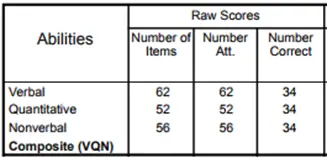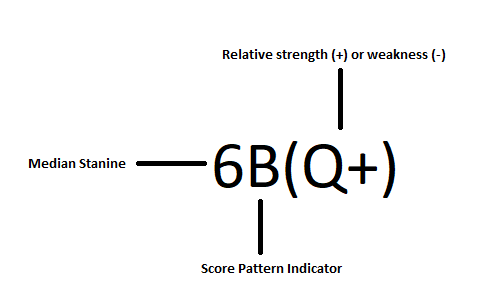Understanding CogAT Scores
The CogAT (Cognitive Abilities Test) measures a student’s reasoning skills in three key areas: Verbal, Quantitative, and Nonverbal. The score report includes different types of scores, such as the Standard Age Score (SAS), percentile ranks, and stanines. These scores help schools identify gifted students and understand how a child’s cognitive abilities compare to others in their age group.
Practice for CogAT Tests by Grade ➜
- CogAT Kindergarten — Level 5/6
- CogAT 1st Grade — Level 7
- CogAT 2nd Grade — Level 8
- CogAT 3rd Grade — Level 9
- CogAT 4th Grade — Level 10
- CogAT 5th Grade — Level 11
- CogAT 6th Grade — Level 12
What is in a CogAT Score Report?
Below we provide two sample charts that represent a real CogAT Score report:


How do You interpret CogAT Scores?
In this section, we break down each component of the charts shown above so you can understand your score report.
|
Raw Score The raw score is calculated first by tallying the total number of questions correctly answered. Students do not lose points for answering questions incorrectly. |
||||||||||
|
Universal Scale Score (USS) The raw score is then converted to a Universal Scale Score, which is a normalized standard score. There are separate USS scores for each of the three batteries. The Composite USS is determined by averaging these three scores. |
||||||||||
|
Standard Age Score (SAS) The Standard Age Score is a normalized age score for all Universal Scale Scores. It has a mean of 100, a standard deviation of 16, and a maximum score of 160. For example, a student who receives a score of 100 on the quantitative battery is considered to have a standard rate of development and potential in that area, while a student who receives a score of 125 on the same battery is considered to have a faster rate of development and potential in that area. |
||||||||||
|
Age Percentile Rank (PR) This score is used to compare students to other students in their age and grade. A percentile rank of 80 means that a student scored better than 80% of students who took the test. A percentile rank of 50 is considered average. |
||||||||||
|
APR Graph This is a visual depiction of the composite and individual battery scores for your student. A score indicator shows the results for each segment of the test. Scores for each section of the assessment are indicated by a diamond shape within a score band. |
||||||||||
|
Age Stanine (S) A stanine is a very broad, simplified score that ranges from 1-9, with 9 being the highest possible score. This score is also normalized for both age and grade groups. In general, stanine scores provide an overall picture of a student's academic abilities. Stanine scores are generally grouped in the following fashion:
|
TestPrep-Online Tutor's Tip:
"When I help parents interpret CogAT scores, I always remind them to look beyond just one number. The SAS and percentile rank give a good snapshot, but I also look at how a student did across each battery—Verbal, Quantitative, and Nonverbal. Strengths in one area can reveal a lot about how a child thinks and learns, even if their composite score isn’t in the gifted range."
How to Read CogAT Score Profiles
CogAT score types are used in conjunction to determine a student's score profile. This is another score type that schools use to understand a student's overall performance on the CogAT, as well as individual strengths and weaknesses. A sample score profile looks like this:

Median Stanine: This is the median stanine score the student receives for the three batteries. If, for example, a student receives a stanine score of 8 on the verbal battery, a stanine score of 2 on the nonverbal battery, and a stanine score of 9 on the quantitative battery, then the median stanine score will be 8.
Score Pattern Indicator: As the name suggests, the score pattern indicator is there to give parents and educators an idea of the pattern of a student’s academic abilities. The Score Pattern Indicator can be represented by the letters A, B, C, and E, with each letter representing a different pattern of ability.
| A | The student demonstrates the same ability in all three batteries. |
| B | In one of the batteries, the student has scored above or below the other two, meaning they seem to have a relative strength or weakness. |
| C | Two of the student’s scores seem to contrast with one another, meaning they have both a relative strength and a relative weakness. |
| E | The student demonstrates extreme differences in their scoring, with at least two of their scores differing by 24 or more raw score points. |
Relative Strength (+) or Weakness (-): This component is represented by Q, N, and V, which stand for Quantitative, Nonverbal, or Verbal Battery, respectively. A (+) sign indicates a relative strength while a (-) indicates a relative weakness.
What CogAT Score is Considered Gifted?
What CogAT score is considered high? What CogAT score is considered gifted? These are questions that many parents, teachers, and students are asking.
Let’s start with the first question- what is a high CogAT score? Well, the answer is not so simple. As we can note from the score types and score profile generated from a student’s test results, the answer is layered: some students may appear to perform more poorly due to an overall weaker raw score, but at closer glance are spotted as extraordinarily talented in one area, and less than average in another. This means that the concept of a high score is flexible, and there is unfortunately no definite answer.
When it comes to what CogAT score is considered gifted, however, the answer becomes a bit clearer. Whether or not a CogAT score is considered gifted is often determined by their Standard Age Score (SAS), percentile ranking, or even simply their raw score.
Every gifted program varies in the exact amount of points a student needs to qualify. Here are just a few examples of gifted programs & their CogAT score requirements:
| John Hopkins Program for Gifted & Talented Youth | Raw Score of 95% |
| Northwestern University Talent Search | Raw Score of 90% |
| Bellevue School District’s Advanced Learning Services | 98th Percentile |
| Intertel | Raw Score of 99% |
How to Prepare for the CogAT
The CogAT is a challenging exam. With increasingly high levels of competition for gifted programs, it is important that your child is ready for test day. At TestPrep-Online, we offer comprehensive, age-specific study packs to ensure that your child is as ready as s/he can be. These packs include practice tests, section-specific sample questions, detailed explanations, and study guides.
CogAT Scores FAQ
A Standard Age Score (SAS) of 130 or above is typically considered strong and may qualify a student for gifted programs. However, qualifying scores vary by school district.
Yes. Each battery is scored separately, but they are also combined into a Composite Score that reflects overall cognitive ability.
Yes, while the CogAT measures reasoning ability, practice helps students become familiar with question types, reduce test anxiety, and improve accuracy—especially in areas like pattern recognition and number relationships.



